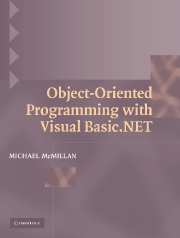Book contents
- Frontmatter
- Contents
- Preface
- Chapter 1 An Overview of the Visual Basic.NET Language
- Chapter 2 An Overview of Object-Oriented Programming
- Chapter 3 Structures
- Chapter 4 Classes
- Chapter 5 Access Modifiers
- Chapter 6 Abstract Classes and Interfaces
- Chapter 7 Implementing the IEnumerable and IComparable Interfaces
- Chapter 8 Designing and Implementing Exception Classes
- Chapter 9 Design Patterns and Refactoring
- Chapter 10 Object Internals: Reflection and Attributes
- Chapter 11 Object Persistence: Serialization
- Chapter 12 Building a Windows Application
- Chapter 13 Database Programming Using ADO.NET
- References
- Index
Chapter 9 - Design Patterns and Refactoring
Published online by Cambridge University Press: 06 July 2010
- Frontmatter
- Contents
- Preface
- Chapter 1 An Overview of the Visual Basic.NET Language
- Chapter 2 An Overview of Object-Oriented Programming
- Chapter 3 Structures
- Chapter 4 Classes
- Chapter 5 Access Modifiers
- Chapter 6 Abstract Classes and Interfaces
- Chapter 7 Implementing the IEnumerable and IComparable Interfaces
- Chapter 8 Designing and Implementing Exception Classes
- Chapter 9 Design Patterns and Refactoring
- Chapter 10 Object Internals: Reflection and Attributes
- Chapter 11 Object Persistence: Serialization
- Chapter 12 Building a Windows Application
- Chapter 13 Database Programming Using ADO.NET
- References
- Index
Summary
It is not enough just to know how to write object-oriented programs; you also have to know how to write object-oriented programs well. As you gain experience writing object-oriented programs, you will discover certain programming idioms that are used over and over again. These idioms are called design patterns.
DESIGN PATTERNS
Design patterns were first described in Design Patterns—Elements of Reusable Object-Oriented Software (Gamma 1995). A design pattern is a solution to a recurring problem in object-oriented design and implementation. There are four parts to a design pattern, as described in Gamma et al.'s book (Gamma 1995, p. 3):
Pattern name—A name for making it easier to discuss using the pattern.
Problem—An explanation of the problem and its context.
Solution—An abstract description of the design problem and how to use VB.NET code to solve it.
Consequences—The pros and cons of implementing the design pattern.
The Shared Factory Method
Using constructors to create instances of classes is not always the preferred approach to instantiating class objects. One problem with constructors is that they don't have names, which can lead to confusing code. Another problem with constructors is that each constructor has to have its own signature, meaning that only one type of class object can be instantiated for each signature.
We can work around these problems by writing methods that create objects. This is a design pattern known as a factory method. In this case, we create a Shared Factory method that can be called without needing an instance of a class.
- Type
- Chapter
- Information
- Object-Oriented Programming with Visual Basic.NET , pp. 202 - 222Publisher: Cambridge University PressPrint publication year: 2004



